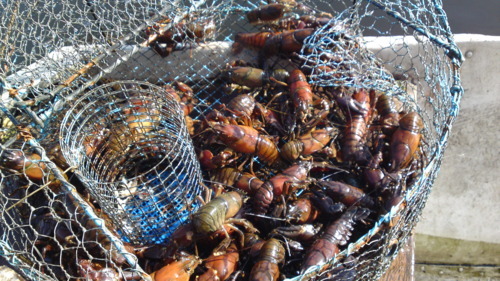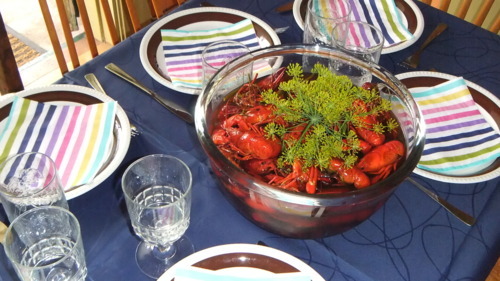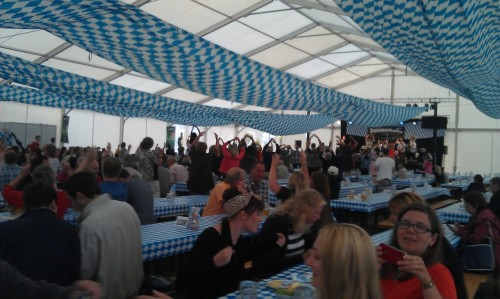Bookmark
Cesium still high in Fukushima fish | The Japan Times Online
www.japantimes.co.jp/text/nn20121026x2.html, posted 2012 by peter in environment food fukushima health japan jpquake
Although the vast majority of fish tested off the Tohoku region remain below recently tightened food safety limits for cesium-134 and cesium-137, government data show that 40 percent of bottom fish, including cod, flounder and halibut, are still above the limit, Ken Buesseler, a marine chemist at the Woods Hole Oceanographic Institution in Massachusetts, wrote in an article published Thursday in the journal Science.
Bookmark
Cesium above new limit in Miyagi beef | The Japan Times Online
www.japantimes.co.jp/text/nn20121019a2.html, posted 2012 by peter in food health japan jpquake
Meat from a cow shipped by a farmer in Tome was found to contain more than 150 becquerels of radioactive cesium per kilogram, the Miyagi Prefectural Government said Wednesday.
The stricter limit of 150 becquerels for beef and rice took effect Oct. 1. The previous limit was 500 becquerels per kilogram.
It is the first time beef with radioactive cesium levels above the tightened limit has been found.
Bookmark
Rice harvested in no-entry zone being checked for radiation levels - AJW by The Asahi Shimbun
ajw.asahi.com/article/0311disaster/fukushima/AJ201210110046, posted 2012 by peter in food fukushima health japan jpquake
Wearing white protective gear and wielding sickles, officials of the Okuma town government on Oct. 10 cut and bundled rice plants grown in the no-entry zone established after last year's nuclear disaster.
The plants were cultivated on an experimental basis to determine the radiation level of rice grown in radioactively contaminated soil.
...
"We cannot imagine when people of this town can return to their homes. It may be several years from now or several decades from now. But we hope that the result of this experiment will help farmers who want to return to this town to resume their farming in the future," said Kiyoyuki Matsumoto, 35, a town government official who is managing the two plots of the rice field.
Photoset
Oktoberfest in Älvsjö, outside Stockholm
wastholm.tumblr.com/post/29057266157/oktoberfest-in-alvsjo-outside-stockholm, posted 2012 by peter in drink food stockholm
Blog Post
Celebrating Our Son's Okuizome
wastholm.tumblr.com/post/21524674447/celebrating-our-sons-okuizome, posted 2012 by peter in food japan
Today we celebrated our son’s okuizome (お食い初め), a Japanese tradition to ensure a long and healthy life. Like in most parts of Japan, we decided to do it on the boy’s 100th day since birth. Clad in Japanese attire, this was how excited he was before the ceremony:

Yoko had spent much of the day cooking all the right dishes for this occasion, using special ingredients that are not necessarily commonplace in Sweden but that we had managed to procure in various places over the last few days. Here’s how it turned out:

Traditionally, the meal consists of grilled sea bream, braised chicken, red sticky rice with beans, clear soup, pickles and vegetables. We added strawberries (for color) and the pastry that looks like a frog (because our boy’s nickname is “Little Frog”). Oh, and that smallest dish contains three pebbles.
Pebbles? — Yes, pebbles. In the ceremony, one of these small stones is picked up with the chopsticks, which are then brought to the infant’s mouth to signify a wish that he always be equipped with good strong teeth.
Yeah, that’s a bit weird. But this tradition stems from the 8th century, and a period that also gave rise to the freaking samurai, so I’m willing to cut it some slack.
After this, still with the chopsticks, the infant is offered, in turn, red rice, soup, rice again, a piece of fish, and finally rice for a third time. The whole procedure is repeated three times. Of course, the child doesn’t actually eat anything; the food merely touches his lips in a symbolic gesture. In this case, it’s an expression of hope that the child never want for food.
After all this excitement, our boy had some milk and a nap, and we adults ate of the ceremonial food.
おめでとう!
Bookmark
she who eats: uses of yuzu: marmalade and more, back to winter 2011
shewhoeats.blogspot.com/2012/02/uses-of-yuzu-marmalade-and-more-back-to.html, posted 2012 by peter in food japan list
So, yuzu. I've made jars after jars of marmalade with this beloved citrus fruit of Japan for the past month or so. In fact, I had more marmalade than I knew what to do with - so I decided to turn them into cakes. And ice-creams. And puddings. And so it goes...
Bookmark
Malthus, a Meal a Day. Or How I Learned to Stop Worrying About the Food and Love the (Population) Bomb. — Conceptual Devices
www.conceptualdevices.com/2011/06/malthus-a-meal-a-day-or-how-i-learned-to-stop-worrying-about-the-food-and-love-the-population-bomb/, posted 2012 by peter in design diy environment food toread
Malthus is an appliance for the kitchen of the future that grows food right next to where you cook it. Malthus consists of a fish tank that holds 400 litres which can support more then 2kg of fish like tilapia, salmon, grey fish or carp. The water is pumped through three cultivated grow beds which filter the water for the fish.
Malthus is designed to optimize space and costs with indoor food production. The weight of the fish tank is comparable to the one of a full bathtub, its width is about the size of two small refrigerators. Its parts are made of elements available in most DIY stores.
Bookmark
麦酒ã¨ç‰¡è £ã¨ãŠã°ã‚“ã–ã„『麦酒庵ã€
www.bakushuan.com/, posted 2011 by peter in beer drink food injapanese japan todo tokyo travel
■常時、日本の地ビールを樽生で10種類
※レギュラービールは和歌山『ナギサビール』(関東初)、長野『南信州ビール』
※大手及び海外のビールは扱っておりません
■日本酒は150種程度
※ビールがメインのお店なので、日本酒のみを楽しまれたい方はご遠慮ください
■焼酎等の蒸留酒、海外のお酒は置いてません
■店内は禁煙です
※ベランダに喫煙スペースを設けています。
Blog Post
Japanese Lunch at Blue Light Yokohama (in Stockholm)
wastholm.tumblr.com/post/10236665881/japanese-lunch-at-blue-light-yokohama-in, posted 2011 by peter in food japan stockholm
Blog Post
Gone Crayfishin'
wastholm.tumblr.com/post/8872442749/gone-crayfishin, posted 2011 by peter in food sweden
I spent last weekend crayfishing in a lake near our family’s summerhouse in the country. We used a new (to us) type of trap, and the catch was better than anything I have ever seen. An example:

We went out twice, setting ten traps each time, and caught around 240 crayfish of legal size, plus at least as many that we had to throw back. Nowadays, crayfish are normally sold by the kilogram, but our relative, who owns the fishing water, is sort of old-school and still sells them by the score (“tjog” in Swedish). With 20 crayfish to a score, he now has twelve score to sell. Swedish crayfish in August are sold at prices approaching or exceeding those of the very finest cuts of meat, and it’s said that it’s a seller’s market this year, so I hope he makes a good deal and I was glad I could help.
Here’s a photo from our vetting procedure. Crayfish of legal size are in the white pails; ones that are to go back in the lake are in the yellow ones. The funny-looking little stick is what we measure them with.

Well, he would have twelve score to sell, except we cooked and ate two score (between five people) later the same day. Swedes cook their crayfish in brine, seasoned with lots of dill and a dash of beer, and eat them cold with bread, cheese and various condiments and side dishes. Crayfish parties are traditionally held in August, usually with liberal amounts of akvavit and other forms of alcohol. Here’s how our crayfish looked when cooked and ready to eat:

We hadn’t really planned on throwing a crayfish party; this was just our little impromptu celebration of a good catch. It’s entirely possible that you have to be a dyed-in-the-wool Swede to enjoy crayfish cooked in this fashion, but I at least thought they were absolutely delicious. There was no akvavit, though, since I was bound to hop on a train and go back home later that same day. Maybe next time.
|< First < Previous 51–60 (102) Next > Last >|


![[photo]](/images/peter_autumn)